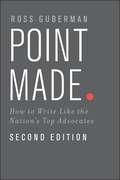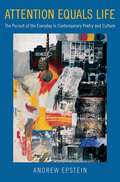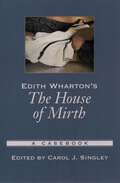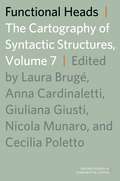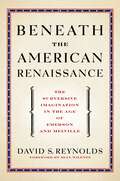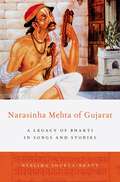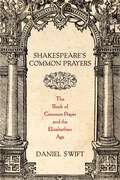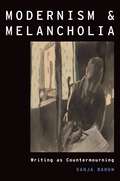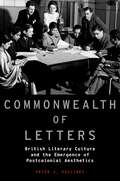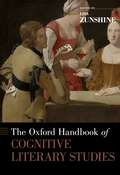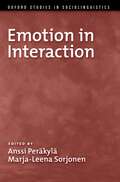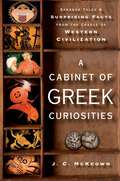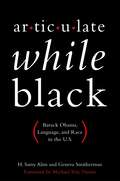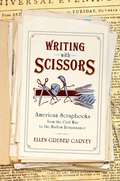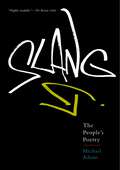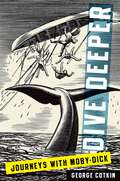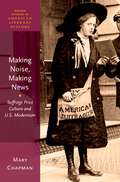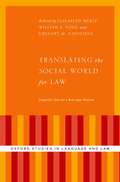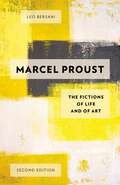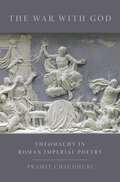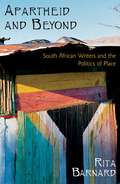- Table View
- List View
Point Made: How to Write Like the Nation's Top Advocates
by Ross GubermanWith Point Made, legal writing expert, Ross Guberman, throws a life preserver to attorneys, who are under more pressure than ever to produce compelling prose. What is the strongest opening for a motion or brief? How to draft winning headings? How to tell a persuasive story when the record is dry and dense? The answers are "more science than art," says Guberman, who has analyzed stellar arguments by distinguished attorneys to develop step-by-step instructions for achieving the results you want. The author takes an empirical approach, drawing heavily on the writings of the nation's 50 most influential lawyers, including Barack Obama, John Roberts, Elena Kagan, Ted Olson, and David Boies. Their strategies, demystified and broken down into specific, learnable techniques, become a detailed writing guide full of practical models. In FCC v. Fox, for example, Kathleen Sullivan conjures the potentially dangerous, unintended consequences of finding for the other side (the "Why Should I Care?" technique). Arguing against allowing the FCC to continue fining broadcasters that let the "F-word" slip out, she highlights the chilling effect these fines have on America's radio and TV stations, "discouraging live programming altogether, with attendant loss to valuable and vibrant programming that has long been part of American culture." Each chapter of Point Made focuses on a typically tough challenge, providing a strategic roadmap and practical tips along with annotated examples of how prominent attorneys have resolved that challenge in varied trial and appellate briefs. Short examples and explanations with engaging titles--"Brass Tacks," "Talk to Yourself," "Russian Doll"--deliver weighty materials with a light tone, making the guidelines easy to remember and apply. In addition to all-new examples from the original 50 advocates, this Second Edition introduces eight new superstar lawyers from Solicitor General Don Verrilli, Deanne Maynard, Larry Robbins, and Lisa Blatt to Joshua Rosencranz, Texas Senator Ted Cruz, Judy Clarke, and Sri Srinvasan, now a D.C. Circuit Judge. Ross Guberman also provides provocative new examples from the Affordable Care Act wars, the same-sex marriage fight, and many other recent high-profile cases. Considerably more commentary on the examples is included, along with dozens of style and grammar tips interspersed throughout. Also, for those who seek to improve their advocacy skills and for those who simply need a step-by-step guide to making a good brief better, the book concludes with an all-new set of 50 writing challenges corresponding to the 50 techniques.
Attention Equals Life: The Pursuit of the Everyday in Contemporary Poetry and Culture
by Andrew EpsteinPoetry has long been thought of as a genre devoted to grand subjects, timeless themes, and sublime beauty. Why, then, have contemporary poets turned with such intensity to documenting and capturing the everyday and mundane? Drawing on insights about the nature of everyday life from philosophy, history, and critical theory, Andrew Epstein traces the modern history of this preoccupation and considers why it is so much with us today. Attention Equals Life argues that a potent hunger for everyday life explodes in the post-1945 period as a reaction to the rapid, unsettling transformations of this epoch, which have resulted in a culture of perilous distraction. Epstein demonstrates that poetry is an important, and perhaps unlikely, cultural form that has mounted a response, and even a mode of resistance, to a culture suffering from an acute crisis of attention. In this timely and engaging study, Epstein examines why a compulsion to represent the everyday becomes predominant in the decades after modernism and why it has so often sparked genre-bending formal experimentation. With chapters devoted to illuminating readings of a diverse group of writers--including poets associated with influential movements like the New York School, language poetry, and conceptual writing--the book considers the variety of forms contemporary poetry of everyday life has taken, and analyzes how gender, race, and political forces all profoundly inflect the experience and the representation of the quotidian. By exploring the rise of experimental realism as a poetic mode and the turn to rule-governed "everyday-life projects," Attention Equals Life offers a new way of understanding a vital strain at the heart of twentieth- and twenty-first century literature. It not only charts the evolution of a significant concept in cultural theory and poetry, but also reminds readers that the quest to pay attention to the everyday within today's frenetic world of and social media is an urgent and unending task.
Edith Wharton's The House of Mirth: A Casebook (Casebooks in Criticism)
Edith Wharton is recognized as one of the twentieth century's most important American writers. The House of Mirth not only initiated three decades of Wharton's popular and critical acclaim, it helped move women's literature into a new place of achievement and prominence. The House of Mirth is perhaps Wharton's best-known and most frequently read novel, and scholars and teachers consider it an essential introduction to Wharton and her work. The novel, moreover, lends itself to a variety of topics of inquiry and critical approaches of interest to readers at various levels. This casebook collects critical essays addressing a broad spectrum of topics and utilizing a range of critical and theoretical approaches. It also includes Wharton's introduction to the 1936 edition of the novel and her discussion of the composition of the novel from her autobiography.
Functional Heads, Volume 7: The Cartography of Syntactic Structures (Oxford Studies in Comparative Syntax)
by Laura Brugé Anna Cardinaletti Giuliana Giusti Nicola Munaro Cecilia PolettoOver the last two decades, functional heads have been one of the privileged objects of research in generative linguistics. However, within this line of inquiry, two alternative approaches have developed: while the cartographic project considers crosslinguistic evidence as crucial for a complete mapping of functional heads in universal grammar, minimalist accounts tend to consider structural economy as literally involving a reduction in the number of available heads. In this volume, some of the most influential linguists who have participated in this long-lasting debate offer their recent work in short, self-contained case studies. The contributions cover all the main layers of recently studied syntactic structure, including such major areas of empirical research as grammaticalization and language change, standard and non-standard varieties, interface issues, and morphosyntax. Functional Heads attempts to map aspects of syntactic structure according to the cartographic approach, and in doing so demonstrates that the differences between cartography and minimalism are perhaps more superficial than substantial.
Beneath the American Renaissance: The Subversive Imagination in the Age of Emerson and Melville
by David S. ReynoldsThe award-winning Beneath the American Renaissance is a classic work on American literature. It immeasurably broadens our knowledge of our most important literary period, as first identified by F.O. Matthiessen's American Renaissance. With its combination of sharp critical insight, engaging observation, and narrative drive, it represents the kind of masterful cultural history for which David Reynolds is known. Here the major works of Emerson, Thoreau, Whitman, Poe, Hawthorne, Melville, and Dickinson receive striking, original readings set against the rich backdrop of contemporary popular writing. Now back in print, the volume includes a new foreword by historian Sean Wilentz that reveals the book's impact and influence. A magisterial work of criticism and cultural history, Beneath the American Renaissance will fascinate anyone interested in the genesis of America's most significant literary epoch and the iconic figures who defined it.
Narasinha Mehta of Gujarat: A Legacy of Bhakti in Songs and Stories
by Neelima Shukla-BhattExploring medieval manuscripts, Gandhi's writings, and performances in multiple religious and non-religious contexts, Narasinha Mehta of Gujarat demonstrates how over five centuries, performers and audiences of devotional songs and hagiographic narratives associated with the saint-poet Narasinha Mehta have sculpted them into popular sources of moral inspiration. Taking Gandhi's use of these works in his social reconstruction programs as an example, the book suggests that when religious forms such as songs and hagiographies of saint-poets of South Asia acquire dimensions of popular culture, they offer a platform for communication among diverse groups. An illuminating study that provides a vivid picture of the Narasinha tradition, Narasinha Mehta of Gujarat will be a crucial resource for anyone seeking to understand the power of religious performative traditions in popular media.
Shakespeare's Common Prayers: The Book of Common Prayer and the Elizabethan Age
by Daniel SwiftSocieties and entire nations draw their identities from certain founding documents, whether charters, declarations, or manifestos. The Book of Common Prayer figures as one of the most crucial in the history of the English-speaking peoples. First published in 1549 to make accessible the devotional language of the late Henry the VIII's new church, the prayer book was a work of monumental religious, political, and cultural importance. Within its rituals, prescriptions, proscriptions, and expressions were fought the religious wars of the age of Shakespeare. This diminutive book--continuously reformed and revised--was how that age defined itself. In Shakespeare's Common Prayers, Daniel Swift makes dazzling and original use of this foundational text, employing it as an entry-point into the works of England's most celebrated writer. Though commonly neglected as a source for Shakespeare's work, Swift persuasively and conclusively argues that the Book of Common Prayer was absolutely essential to the playwright. It was in the Book's ambiguities and its fierce contestations that Shakespeare found the ready elements of drama: dispute over words and their practical consequences, hope for sanctification tempered by fear of simple meaninglessness, and the demand for improvised performance as compensation for the failure of language to fulfill its promises. What emerges is nothing less than a portrait of Shakespeare at work: absorbing, manipulating, reforming, and struggling with the explosive chemistry of word and action that comprised early modern liturgy. Swift argues that the Book of Common Prayer mediates between the secular and the devotional, producing a tension that makes Shakespeare's plays so powerful and exceptional. Tracing the prayer book's lines and motions through As You Like It, Hamlet, Twelfth Night, Measure for Measure, Othello, and particularly Macbeth, Swift reveals how the greatest writer of the age--of perhaps any age--was influenced and guided by its most important book.
Shakespeare's Common Prayers: The Book of Common Prayer and the Elizabethan Age
by Daniel SwiftSocieties and entire nations draw their identities from certain founding documents, whether charters, declarations, or manifestos. The Book of Common Prayer figures as one of the most crucial in the history of the English-speaking peoples. First published in 1549 to make accessible the devotional language of the late Henry the VIII's new church, the prayer book was a work of monumental religious, political, and cultural importance. Within its rituals, prescriptions, proscriptions, and expressions were fought the religious wars of the age of Shakespeare. This diminutive book--continuously reformed and revised--was how that age defined itself. In Shakespeare's Common Prayers, Daniel Swift makes dazzling and original use of this foundational text, employing it as an entry-point into the works of England's most celebrated writer. Though commonly neglected as a source for Shakespeare's work, Swift persuasively and conclusively argues that the Book of Common Prayer was absolutely essential to the playwright. It was in the Book's ambiguities and its fierce contestations that Shakespeare found the ready elements of drama: dispute over words and their practical consequences, hope for sanctification tempered by fear of simple meaninglessness, and the demand for improvised performance as compensation for the failure of language to fulfill its promises. What emerges is nothing less than a portrait of Shakespeare at work: absorbing, manipulating, reforming, and struggling with the explosive chemistry of word and action that comprised early modern liturgy. Swift argues that the Book of Common Prayer mediates between the secular and the devotional, producing a tension that makes Shakespeare's plays so powerful and exceptional. Tracing the prayer book's lines and motions through As You Like It, Hamlet, Twelfth Night, Measure for Measure, Othello, and particularly Macbeth, Swift reveals how the greatest writer of the age--of perhaps any age--was influenced and guided by its most important book.
Modernism and Melancholia: Writing as Countermourning (Modernist Literature and Culture)
by Sanja BahunModernism and melancholia share an intellectual fate: being at once categories, conditions, discourses, modes of expression, and social projects, they feed on their own ambiguity. But modernism and melancholia also share a history: it was in the cultural-historical period we tentatively term "modernism" that a fundamental shift in our understanding of melancholia occurred. What is, then, the relationship between modernism and melancholia? How does it relate to the history of the late nineteenth and early twentieth century? What is the social value of the associated cluster of symbolic rituals that we call mourning? Modernism and Melancholia addresses these questions, as it focuses on the manifestations of melancholia in modernist fiction internationally. Paying close attention to writings by Andrei Bely, Franz Kafka, and Virginia Woolf, Sanja Bahun identifies in modernist fiction a deliberate use of the symptomatology of melancholia to reinvigorate the genre of the novel and address the complexities of contemporary history. Such an exercise establishes writing as a mourning ritual that self-consciously refuses to "heal" or "cure." To describe this paradoxical writing practice, Bahun proposes the term "countermourning." Reversing-or renewing-the ways in which the conceptual scope of melancholia is utilized in modernist studies, this study positions itself at the crossroads of literary studies and intellectual history, and suggests a continuity between the shifting view of melancholia in global modernism.
Commonwealth Of Letters Mlc C: British Literary Culture And The Emergence Of Postcolonial Aesthetics
by Peter J. KallineyCommonwealth of Letters: British Literary Culture and the Emergence of Postcolonial Aesthetics (Modernist Literature and Culture)
by Peter J. KallineyCommonwealth of Letters examines midcentury literary institutions integral to modernism and postcolonial writing. Several organizations central to interwar modernism, such as the BBC, influential publishers, and university English departments, became important sites in the emergence of postcolonial literature after the war. How did some of modernism's leading figures of the 1930s-such as T.S. Eliot, Louis MacNeice, and Stephen Spender-come to admire late colonial and early postcolonial literature in the 1950s? Similarly, why did late colonial and early postcolonial writers-including Chinua Achebe, Kamau Brathwaite, Claude McKay, and Ngugi wa Thiong'o-actively seek alliances with metropolitan intellectuals? Peter Kalliney's original and extensive archival work on modernist cultural institutions demonstrates that this disparate group of intellectuals had strong professional incentives to treat one another more as fellow literary professionals, and less as political or cultural antagonists. Surprisingly, metropolitan intellectuals and their late colonial counterparts leaned heavily on modernist theories of aesthetic autonomy to facilitate their collaborative ventures. For white, metropolitan writers, T.S. Eliot's notion of impersonality could help recruit new audiences and conspirators from colonized regions of the world. For black, colonial writers, aesthetic autonomy could be used to imagine a literary sphere uniquely resistant to the forms of racial prejudice endemic to the colonial system. This strategic collaboration did not last forever, but as Commonwealth of Letters shows, it left a lasting imprint on the ultimate disposition of modernism and the evolution of postcolonial literature.
The Oxford Handbook of Cognitive Literary Studies (Oxford Handbooks)
by Lisa ZunshineThe Oxford Handbook of Cognitive Literary Studies considers, via a variety of methodologies and combinations of interdisciplinary approaches, how the architecture that enables human cognitive processing interacts with cultural and historical contexts. Organized into five parts (Narrative, History, Imagination; Emotions and Empathy; The New Unconscious; Empirical and Qualitative Studies of Literature; and Cognitive Theory and Literary Experience), the volume uses case studies from a wide range of historical periods (from the fourth century BCE to the twenty-first century) and national literary traditions (including South Asian, postcolonial anglophone and francophone, Chinese, Japanese, English, Iranian, Russian, Italian, French, German, and Spanish).
Emotion in Interaction (Oxford Studies in Sociolinguistics)
by Anssi Peräkylä Marja-Leena SorjonenEmotion in Interaction offers a collection of original studies that explore emotion in naturally occurring spoken interaction.
A Cabinet of Greek Curiosities: Strange Tales and Surprising Facts from the Cradle of Western Civilization
by J. C. McKeownThe ancient Greeks were a wonderful people. They gave us democracy, drama, and philosophy, and many forms of art and branches of science would be inconceivable without their influence. And yet, they were capable of the most outlandish behavior, preposterous beliefs, and ludicrous opinions. Like its companion volume, A Cabinet of Roman Curiosities, this is an uproarious miscellany of odd stories and facts, culled from a lifetime of teaching ancient Greek civilization. In some ways, the book demonstrates how much the Greeks were like us. Politicians were regarded as shallow and self-serving; overweight people resorted to implausible diets; Socrates and the king of Sparta used to entertain their children by riding around on a stick pretending it was a horse. Of course, their differences from us are abundantly documented too and the book may leave readers with a few incredulous questions. To ward off evil, were scapegoats thrown down from cliffs, though fitted out with feathers and live birds to give them a sporting chance of survival? Did a werewolf really win the boxing event at the Olympic Games? Were prisoners released on bail so that they could enjoy dramatic festivals? Did anyone really believe that Pythagoras flew about on a magic arrow? Other such mysteries abound in this quirky and richly illustrated journey into the "glory that was Greece." "The loveliest thing on the black earth." Sappho of Lesbos "Well worth getting a copy." Pisistratus of Athens "Meticulously written, a must for every library." Ptolemy of Alexandria "Unputdownable." Atlas the Titan "Fantastic! Incredible!" Cassandra, priestess of Apollo "The ideal gift." Laocoon of Troy "Not too long." Callimachus of Cyrene "I find something new every time I dip in." Archimedes of Syracuse
A Cabinet of Greek Curiosities: Strange Tales and Surprising Facts from the Cradle of Western Civilization
by J. C. McKeownThe ancient Greeks were a wonderful people. They gave us democracy, drama, and philosophy, and many forms of art and branches of science would be inconceivable without their influence. And yet, they were capable of the most outlandish behavior, preposterous beliefs, and ludicrous opinions. Like its companion volume, A Cabinet of Roman Curiosities, this is an uproarious miscellany of odd stories and facts, culled from a lifetime of teaching ancient Greek civilization. In some ways, the book demonstrates how much the Greeks were like us. Politicians were regarded as shallow and self-serving; overweight people resorted to implausible diets; Socrates and the king of Sparta used to entertain their children by riding around on a stick pretending it was a horse. Of course, their differences from us are abundantly documented too and the book may leave readers with a few incredulous questions. To ward off evil, were scapegoats thrown down from cliffs, though fitted out with feathers and live birds to give them a sporting chance of survival? Did a werewolf really win the boxing event at the Olympic Games? Were prisoners released on bail so that they could enjoy dramatic festivals? Did anyone really believe that Pythagoras flew about on a magic arrow? Other such mysteries abound in this quirky and richly illustrated journey into the "glory that was Greece." "The loveliest thing on the black earth." Sappho of Lesbos "Well worth getting a copy." Pisistratus of Athens "Meticulously written, a must for every library." Ptolemy of Alexandria "Unputdownable." Atlas the Titan "Fantastic! Incredible!" Cassandra, priestess of Apollo "The ideal gift." Laocoon of Troy "Not too long." Callimachus of Cyrene "I find something new every time I dip in." Archimedes of Syracuse
Articulate While Black: Barack Obama, Language, and Race in the U.S.
by Geneva Smitherman H. Samy AlimBarack Obama is widely considered one of the most powerful and charismatic speakers of our age. Without missing a beat, he often moves between Washington insider talk and culturally Black ways of speaking--as shown in a famous YouTube clip, where Obama declined the change offered to him by a Black cashier in a Washington, D.C. restaurant with the phrase, "Nah, we straight." In Articulate While Black, two renowned scholars of Black Language address language and racial politics in the U.S. through an insightful examination of President Barack Obama's language use--and America's response to it. In this eloquently written and powerfully argued book, H. Samy Alim and Geneva Smitherman provide new insights about President Obama and the relationship between language and race in contemporary society. Throughout, they analyze several racially loaded, cultural-linguistic controversies involving the President--from his use of Black Language and his "articulateness" to his "Race Speech," the so-called "fist-bump," and his relationship to Hip Hop Culture. Using their analysis of Barack Obama as a point of departure, Alim and Smitherman reveal how major debates about language, race, and educational inequality erupt into moments of racial crisis in America. In challenging American ideas about language, race, education, and power, they help take the national dialogue on race to the next level. In much the same way that Cornel West revealed nearly two decades ago that "race matters," Alim and Smitherman in this groundbreaking book show how deeply "language matters" to the national conversation on race--and in our daily lives.
Writing with Scissors: American Scrapbooks from the Civil War to the Harlem Renaissance
by Ellen Gruber GarveyMen and women 150 years ago grappled with information overload by making scrapbooks-the ancestors of Google and blogging. From Abraham Lincoln to Susan B. Anthony, African American janitors to farmwomen, abolitionists to Confederates, people cut out and pasted down their reading. Writing with Scissors opens a new window into the feelings and thoughts of ordinary and extraordinary Americans. Like us, nineteenth-century readers spoke back to the media, and treasured what mattered to them. In this groundbreaking book, Ellen Gruber Garvey reveals a previously unexplored layer of American popular culture, where the proliferating cheap press touched the lives of activists and mourning parents, and all who yearned for a place in history. Scrapbook makers documented their feelings about momentous public events such as living through the Civil War, mediated through the newspapers. African Americans and women's rights activists collected, concentrated, and critiqued accounts from a press that they did not control to create "unwritten histories" in books they wrote with scissors. Whether scrapbook makers pasted their clippings into blank books, sermon collections, or the pre-gummed scrapbook that Mark Twain invented, they claimed ownership of their reading. They created their own democratic archives. Writing with Scissors argues that people have long had a strong personal relationship to media. Like newspaper editors who enthusiastically "scissorized" and reprinted attractive items from other newspapers, scrapbook makers passed their reading along to family and community. This book explains how their scrapbooks underlie our present-day ways of thinking about information, news, and what we do with it.
Slang: The People's Poetry
by Michael AdamsSlang, writes Michael Adams, is poetry on the down low, and sometimes lowdown poetry on the down low, but rarely, if ever, merely lowdown. It is the poetry of everyday speech, the people's poetry, and it deserves attention as language playing on the cusp of art. In Slang: The People's Poetry, Adams covers this perennially interesting subject in a serious but highly engaging way, illuminating the fundamental question "What is Slang" and defending slang--and all forms of nonstandard English--as integral parts of the American language. Why is an expression like "bed head" lost in a lexical limbo, found neither in slang nor standard dictionaries? Why are snow-boarding terms such as "fakie," "goofy foot," "ollie" and "nollie" not considered slang? As he addresses these and other lexical curiosities, Adams reveals that slang is used in part to define groups, distinguishing those who are "down with it" from those who are "out of it." Slang is also a rebellion against the mainstream. It often irritates those who color within the lines--indeed, slang is meant to irritate, sometimes even to shock. But slang is also inventive language, both fun to make and fun to use. Rather than complain about slang as "bad" language, Adams urges us to celebrate slang's playful resistance to the commonplace and to see it as the expression of an innate human capacity, not only for language, but for poetry.
Dive Deeper: Journeys with Moby-Dick
by George CotkinHerman Melville's epic tale of obsession has all the ingredients of a first rate drama--fascinating characters in solitude and society, battles between good and evil, a thrilling chase to the death--and yet its allusions, digressions, and sheer scope can prove daunting to even the most intrepid reader. George Cotkin's Dive Deeper provides both a guide to the novel and a record of its dazzling cultural train. It supplies easy-to-follow plot points for each of the novel's 135 sections before taking up a salient phrase, image, or idea in each for further exploration. Through these forays, Cotkin traces the astonishing reach of the novel, sighting the White Whale in mainstream and obscure subcultures alike, from impressionist painting circles to political terrorist cells. In a lively and engaging style, Dive Deeper immerses us into the depths of Melville's influence on the literature, film, and art of our modern world. Cotkin's playful wit and critical precision stretch from Camus to Led Zeppelin, from Emerson to Bob Dylan, and bring to life the terrors and wonders of what is arguably America's greatest novel.
Writing with Scissors: American Scrapbooks from the Civil War to the Harlem Renaissance
by Ellen Gruber GarveyMen and women 150 years ago grappled with information overload by making scrapbooks-the ancestors of Google and blogging. From Abraham Lincoln to Susan B. Anthony, African American janitors to farmwomen, abolitionists to Confederates, people cut out and pasted down their reading. Writing with Scissors opens a new window into the feelings and thoughts of ordinary and extraordinary Americans. Like us, nineteenth-century readers spoke back to the media, and treasured what mattered to them. In this groundbreaking book, Ellen Gruber Garvey reveals a previously unexplored layer of American popular culture, where the proliferating cheap press touched the lives of activists and mourning parents, and all who yearned for a place in history. Scrapbook makers documented their feelings about momentous public events such as living through the Civil War, mediated through the newspapers. African Americans and women's rights activists collected, concentrated, and critiqued accounts from a press that they did not control to create "unwritten histories" in books they wrote with scissors. Whether scrapbook makers pasted their clippings into blank books, sermon collections, or the pre-gummed scrapbook that Mark Twain invented, they claimed ownership of their reading. They created their own democratic archives. Writing with Scissors argues that people have long had a strong personal relationship to media. Like newspaper editors who enthusiastically "scissorized" and reprinted attractive items from other newspapers, scrapbook makers passed their reading along to family and community. This book explains how their scrapbooks underlie our present-day ways of thinking about information, news, and what we do with it.
Making Noise, Making News: Suffrage Print Culture and U.S. Modernism (Oxford Studies in American Literary History #6)
by Mary ChapmanFor most people, the U.S. suffrage campaign is encapsulated by images of iconic nineteenth-century orators like the tightly coifed Susan B. Anthony or the wimpled Elizabeth Cady Stanton. However, as Mary Chapman shows, the campaign to secure the vote for U.S. women was also a modern and print-cultural phenomenon, waged with humor, creativity, and style. Making Noise, Making News also understands modern suffragist print culture as a demonstrable link between the Progressive Era's political campaign for a voice in the public sphere and Modernism's aesthetic efforts to re-imagine literary voice. Chapman charts a relationship between modern suffragist print cultural "noise" and what literary modernists understood by "making it new," asserting that the experimental tactics of U.S. suffrage print culture contributed to, and even anticipated, the formal innovations of U.S. literary modernism. Drawing on little-known archives and featuring over twenty illustrations, Making Noise, Making News provides startling documentation of Marianne Moore's closeted career as a suffrage propagandist, the persuasive effects of Alice Duer Miller's popular poetry column, Asian-American author Sui Sin Far's challenge to the racism and classism of modern suffragism, and Gertrude Stein's midcentury acknowledgement of intersections between suffrage discourse and literary modernism.
Translating the Social World for Law: Linguistic Tools for a New Legal Realism (Oxford Studies in Language and Law)
by Elizabeth Mertz William K. Ford Gregory MatoesianThis volume examines the linguistic problems that arise in efforts to translate between law and the social sciences. We usually think of "translation" as pertaining to situations involving distinct languages such as English and Swahili. But realistically, we also know that there are many kinds of English or Swahili, so that some form of translation may still be needed even between two people who both speak English-including, for example, between English speakers who are members of different professions. Law and the social sciences certainly qualify as disciplines with quite distinctive language patterns and practices, as well as different orientations and goals. In coordinated papers that are grounded in empirical research, the volume contributors use careful linguistic analysis to understand how attempts to translate between different disciplines can misfire in systematic ways. Some contributors also point the way toward more fruitful translation practices. The contributors to this volume are members of an interdisciplinary working group on Legal Translation that met for a number of years. The group includes scholars from law, philosophy, anthropology, linguistics, political science, psychology, and religious studies. The members of this group approach interdisciplinary communication as a form of "translation" between distinct disciplinary languages (or, "registers"). Although it may seem obvious that professionals in different fields speak and think differently about the world, in fact experts in law and in social science too often assume that they can communicate easily when they are speaking what appears to be the "same" language. While such experts may intellectually understand that they differ regarding their fundamental assumptions and uses of language, they may nonetheless consistently underestimate the degree to which they are actually talking past one another. This problem takes on real-life significance when one of the fields is law, where how knowledge is conveyed can affect how justice is meted out.
Marcel Proust: The Fictions of Life and of Art
by Leo BersaniOxford University Press published eminent literary critic Leo Bersani's first book, on Proust, in 1965, but the work has long been out of print. This new edition comes in response to a recent renewal of interest among philosophers of literature, among others, and features a new preface from the author.
Apartheid and Beyond: South African Writers and the Politics of Place
by Rita BarnardApartheid and Beyond offers trenchant, historically sensitive readings of writings by Coetzee, Gordimer, Fugard, Tlali, Dike, Magona, and Mda, focusing on the intimate relationship between place, subjectivity, and literary form. It also explores the way apartheid functioned in its day-to-day operations as a geographical system of control, exerting its power through such spatial mechanisms as residential segregation, bantustans, passes, and prisons. Throughout the study, Rita Barnard provides historical context by highlighting key events such as colonial occupation, the creation of black townships, migration, forced removals, the emergence of informal settlements, and the gradual integration of white cities. Apartheid and Beyond is both an innovative account of an important body of politically inflected literature and an imaginative reflection on the socio-spatial aspects of the transition from apartheid to democracy.
